Construction of FRET-based metallacycles with efficient photosensitization efficiency and photocatalytic activity
Peipei Ji,Yixiong Hu,Zhiyong Zeng,Yute Wng,Bo Song,Ynrong Jing,Hito Sun,Ming Wng,Wenwei Qiu,*,Lin Xu,c,*
a Shanghai Key Laboratory of Green Chemistry and Chemical Processes,Shanghai Frontiers Science Center of Molecule Intelligent Syntheses,Shanghai Engineering Research Center of Molecular Therapeutics and New Drug Development,School of Chemistry and Molecular Engineering,East China Normal University,Shanghai 200062,China
b State Key Laboratory of Precision Spectroscopy,East China Normal University,Shanghai 200241,China
c Institute of Eco-Chongming,Shanghai 202162,China
Keywords:Self-assembly Metallacycle FRET Photosensitization Photocatalytic
ABSTRACT The fabrication of highly effective photosensitizers has received considerable attention because of their attractive functions and applications in the fields of photodynamic therapy,photosynthesis,photocatalysis, etc.Thus,it is highly desirable to develop a new approach to enhance photosensitization efficiency.Herein,through coordination-driven self-assembly,a series of metallacycles with efficient fluorescence resonance energy transfer (FRET) were effectively constructed,which displayed higher photosensitization efficiency and photocatalytic activity than their model metallacycles without FRET due to broadband absorption and singlet energy transfer from the energy acceptor to the energy donor.Moreover,iodization of fluorophores induced a significant enhancement of the photosensitization efficiency and photocatalytic activity of the metallacycles.This research provides an efficient strategy for improving photosensitization efficiency and a promising platform for the preparation of effective photosensitizers and photocatalysts.
During recent decades,the development of new photosensitizers has attracted much attention due to their wide application in the fields of photodynamic therapy [1–4],photosensitive catalysis [5–9] and 3D printing [10,11].Photosensitization efficiency is an important parameter to evaluate the performance of photosensitizers; thus,improving photosensitization efficiency is a longterm pursuit in this field [12–15].In the photosensitization process,increasing the spin-orbit coupling (SOC) constant or decreasing the energy level difference between the single and triple excited states (ΔEST) can increase the intersystem crossing (ISC) rate to improve the photosensitization efficiency [16].At present,introducing multiple heavy atoms (Br,I,Pt,etc.) to promote spin-orbit coupling is a common method to improve photosensitization efficiency [17,18].Incorporating aπ-conjugated system into photosensitizer molecules through covalent organic synthesis to reduce the energy level difference (ΔEST) of S1to T1through separation of the frontier molecular orbital between the HOMO and LUMO is another effective strategy [19,20].For example,Liu and co-workers demonstrated polymerization-enhanced photosensitization,which promotes the transition of the photosensitizer from S1to T1and can improve its light absorption capacity for higher photosensitization efficiency than the small-molecule analogues [21].Therefore,the development of a new approach to enhance photosensitization efficiency is of great value.
At present,most reported photosensitizers are based on a unichromophore profile,in which UV-vis absorption covers only a small major absorption band in the visible spectrum,which is detrimental to the application of photosensitizers,especially with broadband excitation light source such as solar light [22,23].However,FRET systems containing at least two kinds of chromophores(named energy donors and energy acceptors,respectively) show broadband absorption in the visible spectrum since both the energy donors and the energy acceptors exhibit strong absorption in the visible spectral region with different wavelengths [24–30].Therefore,FRET was used to enhance light absorption by accessing strong and broadband absorption in the visible region [31–36].As shown in Fig.1,in FRET systems,both the energy donor and the energy acceptor can be excited upon irradiation with visible light as well as singlet energy transfer from the energy donor to the energy acceptor,producing the triplet excited state in turn,which induces higher photosensitization efficiency compared to that of reference photosensitizers that are based on a unichromophore profile.Thus,we envision that the construction of photosensitizers with FRET might be an effective approach to improving the effi-ciency of photosensitization.

Fig.1.Mechanism of a unichromophore photosensitizer (a) and a multichromophore photosensitizer with FRET (b).
Coordination-driven self-assembly,based on metal-ligand coordination interactions,has been proven to be an efficient strategy to construct functionalized discrete 2D metallacycles and 3D metallacages [37–48].This strategy provides considerable synthetic advantages,such as few steps and fast and facile preparation of the final products.More importantly,the coordination-driven selfassembly strategy allows precise control over the shape and size of the final assemblies as well as the distribution and total number of incorporated functional moieties [49–57].For example,recently,we effectively constructed a FRET-based metallacycle through a coordination-driven self-assembly strategy with coumarin and rhodamine as the energy donor and the energy acceptor,respectively,which presented the first successful example of real-time monitoring of the process and dynamics of coordination-driven selfassembly [58].Therefore,coordination-driven self-assembly is a very efficient method of preparing FRET systems.
Based on the consideration that introducing both heavy atoms and the FRET process could enhance the photosensitization effi-ciency,in this study,we constructed a FRET-based hexagonal metallacycle M1 through coordination-driven self-assembly (Scheme 1).For M1,coumarin chromophore was selected as the energy donor,and diiodo-BODIPY chromophore was selected not only as the energy acceptor but also as the photosensitive unit.To explore the effect of introducing iodine atoms on the photosensitivity efficiency,FRET-based model metallacycle M2 functionalized with coumarin and BODIPY chromophores was designed and prepared.Additionally,in order to investigate the effect of the FRET process on the photosensitivity efficiency and to determine the Förster energy transfer efficiency,a series of model metallacycles M3,M4,and M5 functionalized with diiodo-BODIPY,BODIPY,or coumarin chromophore were also prepared.As expected,compared with the model metallacycles M3 and M4 containing only the terminal acceptor (diiodo-BODIPY or BODIPY chromophore),the FRET-based metallacycles M1 and M2 with broad absorption bands in the visible region showed higher photosensitization efficiency and photocatalytic photooxidation activity,respectively.Moreover,metallacycles M1 and M3 with diiodo-BODIPY chromophore displayed higher photosensitization efficiency and photocatalytic activity than the corresponding metallacycles M2 and M4 with BODIPY chromophore,respectively.The results indicated that the introduction of both heavy atoms and the FRET process are efficient strategies for enhancing the photosensitization efficiency of photosensitizers.
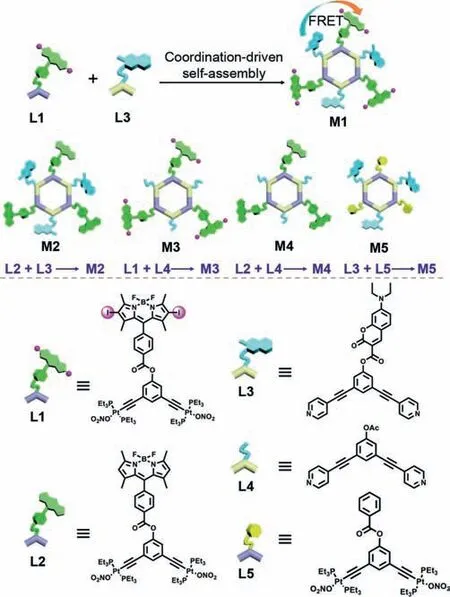
Scheme 1.Schematic illustration of the coordination-driven self-assembly of hexagonal metallacycles M1-M5 and the chemical structures of building blocks L1-L5.
The 120° diiodo-BODIPY-containing diplatinum(II) building block L1 and BODIPY-containing diplatinum(II) building block L2,chosen as the energy acceptors and photosensitive units,were designed and synthesised through an esterification reaction,as presented in the Supporting Information (Scheme 1 and Schemes S1-S4 and Figs.S1-S12 in Supporting information).The 120odipyridyl building block L3,labelled with coumarin as an energy donor,was designed and synthesised according to the reported methods.Moreover,with the aim of investigating the energy transfer efficiencies,model building blocks L4 and L5 without any chromophore were also designed and synthesised through an esterification reaction (Scheme 1 and Schemes S5-S7 in Supporting information).
According to the design principles of coordination-driven selfassembly,the self-assembly of three 120° donor ligands and three 120° acceptor ligands can produce a discrete hexagonal metallacycle [57,58].By stirring a mixture of 120° acceptor ligand L1 and 120° donor ligand L3 in a stoichiometric ratio in acetone/water(5/1,v/v) at 50°C,the pivotal hexagonal metallacycle M1 was obtained in almost quantitative yield (Scheme 1 and Scheme S8 in Supporting information).Furthermore,the model metallacycles M2-M5 were prepared through the coordination-driven selfassembly of ligands L1-L5 (Scheme 1 and Schemes S9-S14 in Supporting information).The formation of hexagonal metallacycles M1-M5 with a discrete and highly symmetric scaffold was supported by multinuclear NMR spectroscopy (1H,31P{1H},13C,2D DOSY,1H-1H COSY,1H-1H NOESY) (Figs.S13-S45 in Supporting information).All31P{1H} NMR spectra of M1-M5 showed a sharp singlet,which shifted upfield from the starting di-Pt(II) acceptors.For instance,in the1H NMR spectrum,the peaks ofα- andβhydrogen of M1 showed downfield shifts (forα-H,Δδ≈0.39 ppm;forβ-H,Δδ≈0.41 ppm) compared with 120° monodipyridyl donor L3,which was associated with the formation of Pt-N bonds (Figs.2a and b).Moreover,M1 displayed a sharp singlet at 16.86 ppm,shifted upfield by approximately 4.53 ppm compared with the corresponding starting acceptor L1 singlet.The upfield shift,as well as the decrease of coupling of the flanking195Pt satellites (e.g.,ca.ΔJP-Pt=-126.0 Hz for M1),was attributed to electron backdonation from the platinum atoms (Figs.2c and d).Furthermore,the characterization by 2D1H NMR techniques is consistent with the structure of discrete metallacycles.For example,cross-peaks between the signals of PEt3protons (CH2and CH3) and pyridine protons (α- andβ-hydrogen) appeared in 2D1H-1H NOESY.The signals supported the structure of metallacycles based on the formation of Pt-N bonds.In addition,the observation of a single band in 2D DOSY supported the formation of isolated species.
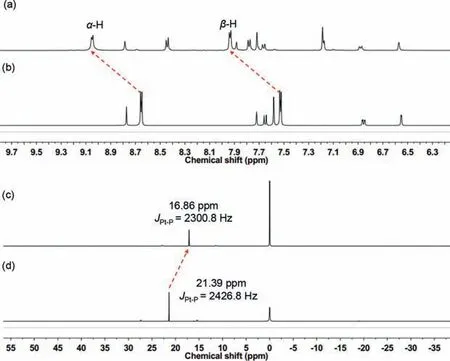
Fig.2.Partial 1H NMR spectra (500 MHz,acetone-d6,298 K) of metallacycle M1 (a) and 120° dipyridyl donor L3 (b).31P NMR spectra (202 MHz,acetone-d6,298 K) of metallacycle M1 (c) and 120° diplatinum(II) acceptor L1 (d).

Fig.3.Simulated geometric structures of metallacycles M1 (a),M2 (b).
All attempts to grow X-ray-quality single crystals of hexagonal metallacycles M1-M5 proved unsuccessful.The GFN2-xTB (geometry,frequency,noncovalent,extended tight binding) semiempirical tight-binding method was employed to acquire further insight into the structural characteristics of these metallacycles.Molecular simulation indicated that metallacycles M1-M5 all featured a very similar and roughly planar hexagonal ring with an internal diameter of approximately 3.0 nm (Fig.3 and Fig.S46 in Supporting infortion).Moreover,the coumarin units and BODIPY units in metallacycle M1 were close to each other at a distance of approximately 1.9 nm,which fully satisfies the requirements of FRET for the distance (<10 nm) between the donor and the receptor fluorophores(Fig.3).
BODIPY is a versatile chromophore with numerous advantageous properties,such as strong absorption of visible light,easy functionalization,and excellent photostability [59–61].To date,BODIPY/diiodo-BODIPY dyes have been widely used in the fields of photodynamic therapy,light harvesting,bioimaging,fluorescent probes,etc.[62–65].In this study,coumarin and BODIPY/diiodo-BODIPY were selected as the FRET donor and acceptor fluorophores,respectively,because the emission spectrum of coumarin and the absorption spectrum of BODIPY/diiodo-BODIPY have a large overlap,which is beneficial for FRET.To investigate the energy transfer from coumarin to BODIPY/diiodo-BODIPY,the absorption and emission spectra of these ligands and metallacycles were measured (Fig.4,Table S1,Figs.S47 and S48 in Supporting infortion).The ligands L1 and L2 gave maximum absorption at 534 nm and 500 nm,respectively.However,ligand L1 showed weaker orange emission at 562 nm than L2 displaying bright green emission at 520 nm,which was attributed to the heavy atom effects resulting in absorption and emission redshifts and fluorescence quenching.The energy donor L3 had maximum absorption at 427 nm and blue emission at 468 nm.As shown in Figs.4a and e,the normalized absorption spectra of L1 and L2 overlapped with the emission spectrum of L3,which was favourable for FRET within metallacycles M1 and M2.Likewise,the normalized absorption spectra of metallacycles M3 and M4 displayed overlap with the emission spectrum of M5 (Figs.4b and f).However,the overlap between M4 and M5 was greater than that between M3 and M5,which is attributed to the absorption redshift of 34 nm caused by the introduction of iodine atoms into M3.
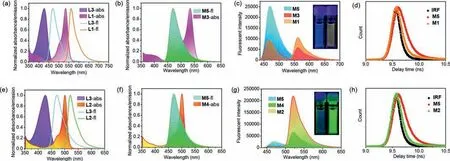
Fig.4.(a) Normalized emission spectra of ligands L1 and L3 (30 μmol/L) and absorption spectra of L1 and L3 (30 μmol/L).(b) Normalized emission spectrum of M5(10 μmol/L) and absorption spectrum of M3 (10 μmol/L).(c) Fluorescence emission spectra of metallacycles M1,M3 and M5 (10 μmol/L).(d) Fluorescence lifetimes of M5 and M1 upon excitation at 427 nm (10 μmol/L).(e) Normalized emission spectra of ligands L2 and L3 (30 μmol/L) and absorption spectra of L2 and L3 (30 μmol/L).(f)Normalized emission spectrum of M5 (10 μmol/L) and absorption spectrum of M4 (10 μmol/L).(g) Fluorescence emission spectra of metallacycles M2,M4 and M5 (10 μmol/L)in acetone.(h) Fluorescence lifetimes of M5 and M2 upon excitation at 427 nm (10 μmol/L) (λex=427 nm; slit (5,5)).
Moreover,when excited at the optimal wavelength for coumarin,metallacycle M1 showed stronger emission at 562 nm than metallacycle M3 and weaker emission at 469 nm than the coumarin-modified metallacycle M5 (Fig.4c).Similarly,metallacycle M2 showed stronger emission at 522 nm than metallacycle M4 and weaker emission at 469 nm than metallacycle M5 (Fig.4g),which all indicated a typical FRET process that generally causes a decrease in the donor emission and an increase in the accepter emission.Based on the ratio between the fluorescence intensities of the donor (coumarin) in the absence (for metallacycle M5) and presence (for metallacycles M1 and M2) of the acceptor (BODIPY),the energy transfer efficiency (ΦET) from coumarin to BODIPY in metallacycles M1 and M2 was calculated to be 60.9% and 80.1%,respectively.Metallacycle M1 showed a lowerΦETthan metallacycle M2,which was attributed to the redshifted absorption spectrum of L1 decreasing the overlap between the emission spectrum of energy donor and the absorption spectrum of energy acceptor.Moreover,the fluorescence lifetime of metallacycle M1 (0.11 ns) or M2 (0.07 ns) was shorter than that of metallacycle M5 (0.27 ns),which strongly supported the existence of the energy transfer process from coumarin to diiodo-BODIPY/BODIPY in metallacycles M1 and M2 (Figs.4d and h) [66].
During the past several decades,1O2has been widely applied in photodynamic therapy (PDT),photochemistry,and catalysis [67,68].Moreover,as a photosensitizer,BODIPY is able to produce singlet oxygen (1O2) for photocatalysis and PDT [69,70].As one of the most important parameters of photosensitizers,the1O2generation efficiencies of M1-M4 were determined to evaluate their photosensitization efficiencies.Herein,9,10-dimethylanthracene (DMA),which can react with1O2to form endoperoxide and thereby decrease its emission,was used to evaluate the1O2generation ability of metallacycles M1-M4 (Fig.5).As shown in Fig.S49 (Supporting information),the fluorescence emission of DMA at 400-500 nm decreased rapidly upon photoirradiation,confirming the successful generation of1O2by the photosensitizer.The1O2generation rate can be quantitatively evaluated by plotting ln(A0/At) against the irradiation time (Figs.5a and b,Table S2 in Supporting information).It is worth noting that the singlet oxygen generation rates of ligands L1 and L2 were almost the same as that of the metallacycles M3 and M4,which showed that the formation of metallacycles did not affect singlet oxygen capacity of the ligands.Due to the absence of photosensitive unit diiodo-BODIPY/BODIPY,L3 and M5 did not have the ability to produce singlet oxygen (Fig.5c).According to the data fitting results,the singlet oxygen generation rates of metal lacycles M1-M4 were 9.48 min-1,0.30 min-1,5.04 min-1,and 0.16 min-1,respectively (Fig.5d).The relative changes in the DMA fluorescence intensity of metallacycle M1 exhibited the highest1O2generation ability compared with any other metallacycle,approximately 31.6-fold,1.88-fold and 59.2-fold higher than those of M2,M3 and M4,respectively.Notably,due to the introduction of heavy atoms (iodine atoms) to enhance the spin-orbit coupling of the photosensitizer,the relative changes in the DMA fluorescence intensity of M1 and M3 were both higher than those of M2 and M4,respectively.Additionally,FRET-based metallacycles M1 and M2 were more efficient than unichromophore-based metallacycles M3 and M4 for the photooxidation of DMA,respectively.For instance,the singlet oxygen generation efficiency of metallacycle M1 was nearly twice that of metallacycle M3.That was because the occurrence of the FRET process resulting in broadband absorption in the visible region enhanced the photosensitization ability of the photosensitizers.Thus,FRET process in combination with heavy atom effect could increase the photosensitization ability of the photosensitizer,although heavy atom effect plays more pivotal role in1O2generation than FRET in these cases.
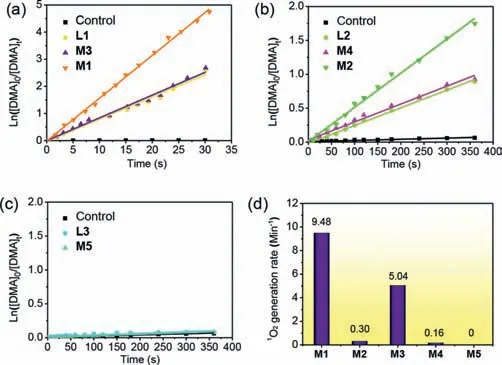
Fig.5.The decomposition of DMA by (a) L1,M3,M1,(b) L2,M4,M2,(c) L3,M5 in acetone.(d) The histogram of 1O2 generation rate of M1-M4.
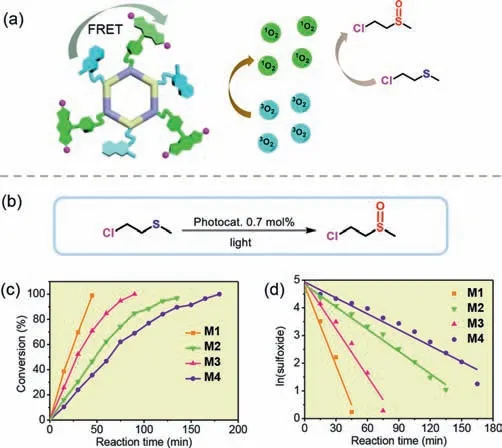
Fig.6.(a) Generation of singlet oxygen (1O2) and the photooxidation reaction of M1.(b) Photooxidation of sulfides from CEES to CEESO.(c) Kinetic plot of the photooxidation of sulfides catalysed by M1-M4 under irradiation.(d) Calculation of the pseudo-first-order kinetic rate constant, k,from the slope of the ln[sulfoxide] vs.time plot,where [sulfoxide]=100 - (sulfide conversion).
According to previous studies,BODIPY dyes can generate1O2for the photooxidation of sulphides [71,72].To demonstrate the utility of the photosensitizer,we employed a simple 2-chloroethyl methyl sulfide (CEES,a chemical warfare agent simulant of mustard gas) as a model substrate to evaluate the oxidative catalytic activity of metallacycle M1 (Fig.6).For comparison,oxidative catalytic activities of metallacycles M2,M3,and M4 were also investigated.Since the singlet oxygen generation rates of ligands L1 and L2 were almost the same as that of the metallacycles M3 and M4,respectively,oxidative catalytic activities of metallacycles ligands L1 and L2 were not conducted.Moreover,due to the absence of photosensitive unit diiodo-BODIPY/BODIPY,L3 and M5 did not have the ability to produce singlet oxygen (Fig.5c),the photocatalytic activity of L3 and M5 were not investigated yet.The components of the reaction systems were identified and quantified through gas chromatography-mass spectrometer (GC-MS) analysis.The results showed that all metallacycles M1-M4 could effectively catalyze the oxidation of sulfide with outstanding conversion rates while metallacycle M1 displayed the best catalytic performance (Fig.6c).For instance,full conversion from CEES to monooxygenated-sulfoxide (CEESO) but not to the toxic sulfone(CEESO2) catalyzed by metallacycle M1 was observed after 45 min of 6 W white LED irradiation.With the same reaction conditions,metallacycles M2,M3,and M4 exhibited 47%,71% and 35% conversion,respectively,after 45 min of reaction.The turnover frequency(TOF) of M1-M4 was calculated to 80.78 h-1,23.66 h-1,47.74 h-1,16.10 h-1,respectively (Fig.6d and Table S3 in Supporting information).The results indicated that the introduction of the heavy atoms as well as FRET system were effective methods for improving photocatalytic efficiency.
To study the adaptability of the photosensitizer to the substrate,the photocatalytic oxidation activity of the thioether derivatives was also studied (Table 1 and Figs.S50-S64 in Supporting information).Considering that metallacycle M1 has the best catalytic performance,metallacycle M1 was chosen as catalyst to catalyze the oxidation of sulfide compounds with different substituents and steric hindrance,the results showed that the catalytic effect of mono-substituted methyl phenyl sulfide was not particularly affected by the introduction of electron-donating group or electronwithdrawing group with low steric hindrance (Table 1,entries 1-7).However,with the introduction of conjugated substituents,such as diphenylthioether,the catalytic effect was sharply reduced,and the catalytic efficiency was not significantly improved by prolongingthe reaction time (Table 1,entry 8).Phenyl(trifluoromethyl)sulfide,with a strong electron-withdrawing group,did not produce the corresponding sulfoxide products (Table 1,entry 9).The oxygenation of dibenzo[b,d]thiophene could not be realized under our catalytic conditions since the conjugation effect reduces the electron cloud density of sulfur (Table 1,entry 10).Thianthrene was proved to be inferior for this oxygenation due to the formation of byproducts (Table 1,entry 11).It is gratifying that phenoxathiine and alkyl sulfides were compatible with our oxidation system,even with sensitive groups (Table 1,entries 12-14).From the above data,it could be seen that a relatively efficient photooxidation of sulfides was achieved in most cases,demonstrating the general applicability of metallacycle M1 as a highly efficient photocatalyst.
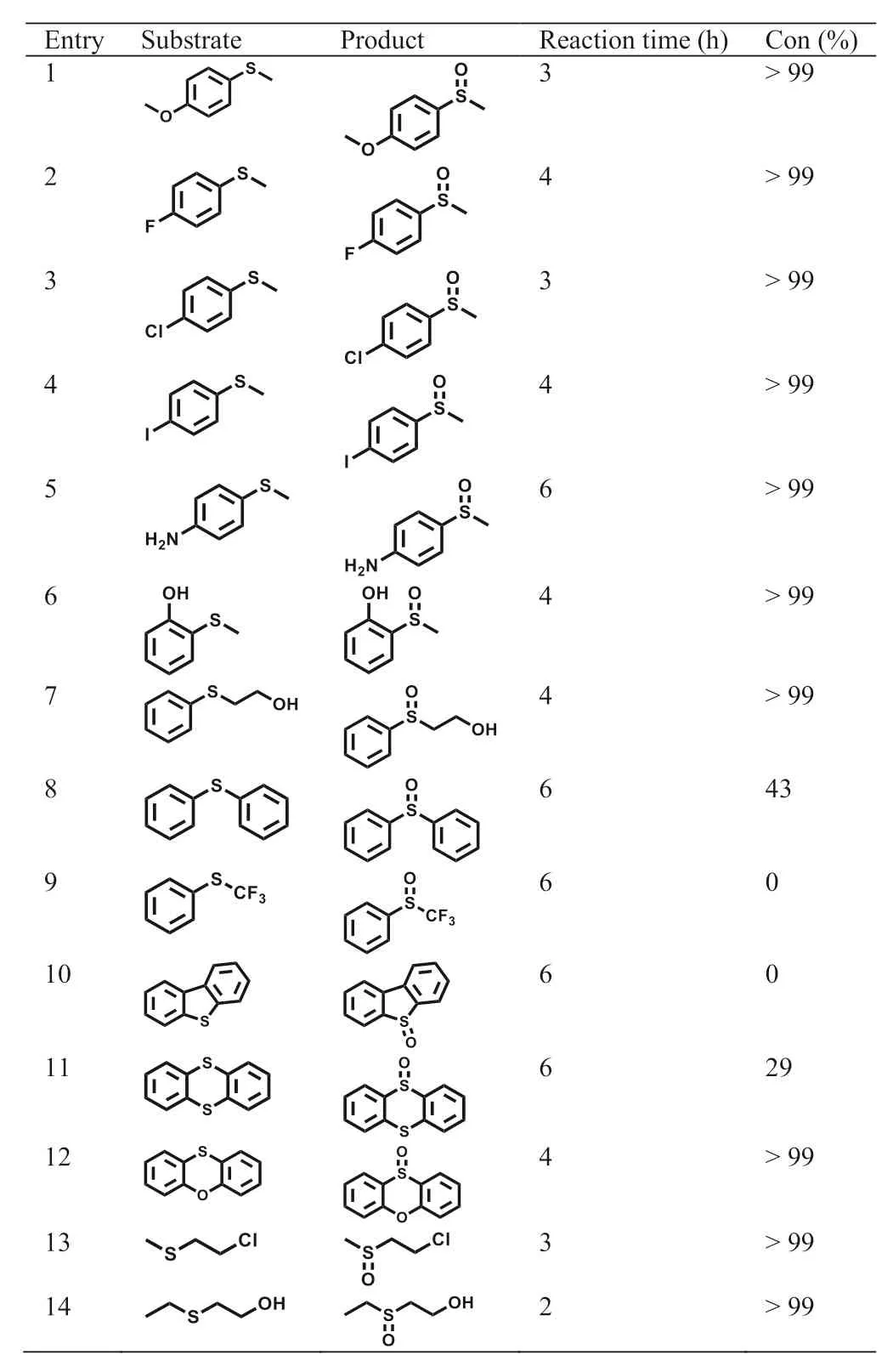
Table 1 Results of selective oxidation of various sulfides catalysed by M1.
In summary,we have developed a strategy to utilize FRET and heavy atom effects simultaneously to improve the photosensitization efficiency and photocatalytic activity of photosensitizers.Through coordination-driven self-assembly,the discrete and highly symmetric hexagonal metallacycle M1 bearing precise numbers of coumarin and diiodo-BODIPY moieties was effectively constructed.In comparison with the unichromophore-based metallacycles M3 and M4,the FRET-based metallacycles M1 and M2 displayed higher photosensitization efficiency for generating1O2and photocatalytic activity for the photooxidation of sulfides.Moreover,metallacycles M1 and M3 with iodination showed higher photosensitive efficiency and photocatalytic activity than metallacycles M2 and M4 without iodination,respectively.This study demonstrates a successful strategy for improving photosensitization effi-ciency and photocatalytic activity.Furthermore,this research provides a prospective platform for designing efficient photosensitizers and for the application of these compounds in photocatalysis.
Declaration of competing interest
The authors declare that they have no known competing financial interests or personal relationships that could have appeared to influence the work reported in this paper.
Acknowledgments
This work was supported by the National Nature Science Foundation of China (No.21871092),Program of Shanghai Outstanding Academic Leaders (No.21XD1421200),the Fundamental Research Funds for the Central Universities,and 2021 Academic Innovation Ability Enhancement Plan for Excellent Doctoral Students of East China Normal University (No.YBNLTS2021-025).
Supplementary materials
Supplementary material associated with this article can be found,in the online version,at doi:10.1016/j.cclet.2022.05.025.
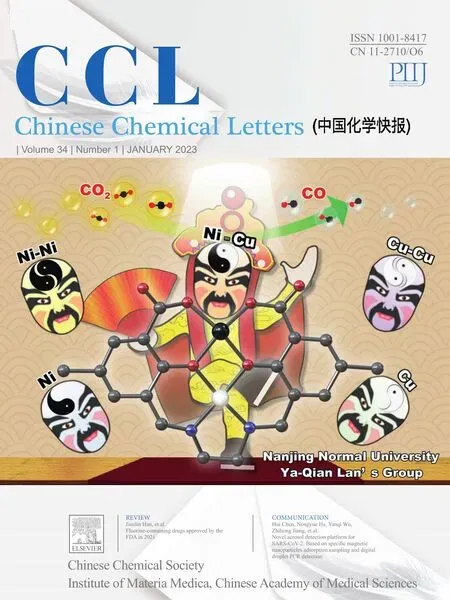 Chinese Chemical Letters2023年1期
Chinese Chemical Letters2023年1期
- Chinese Chemical Letters的其它文章
- Diabetic wound healing activated by supramolecular cascade reaction
- MBenes: Two-dimensional transition-metal borides with ordered metal vacancies
- Wet-adhesive materials of oral and maxillofacial region: From design to application
- Diverse catalytic systems for nitrogen-heterocycle formation from O-acyl ketoximes
- Fluorine-containing drugs approved by the FDA in 2021
- The development and application of dual-comb spectroscopy in analytical chemistry
